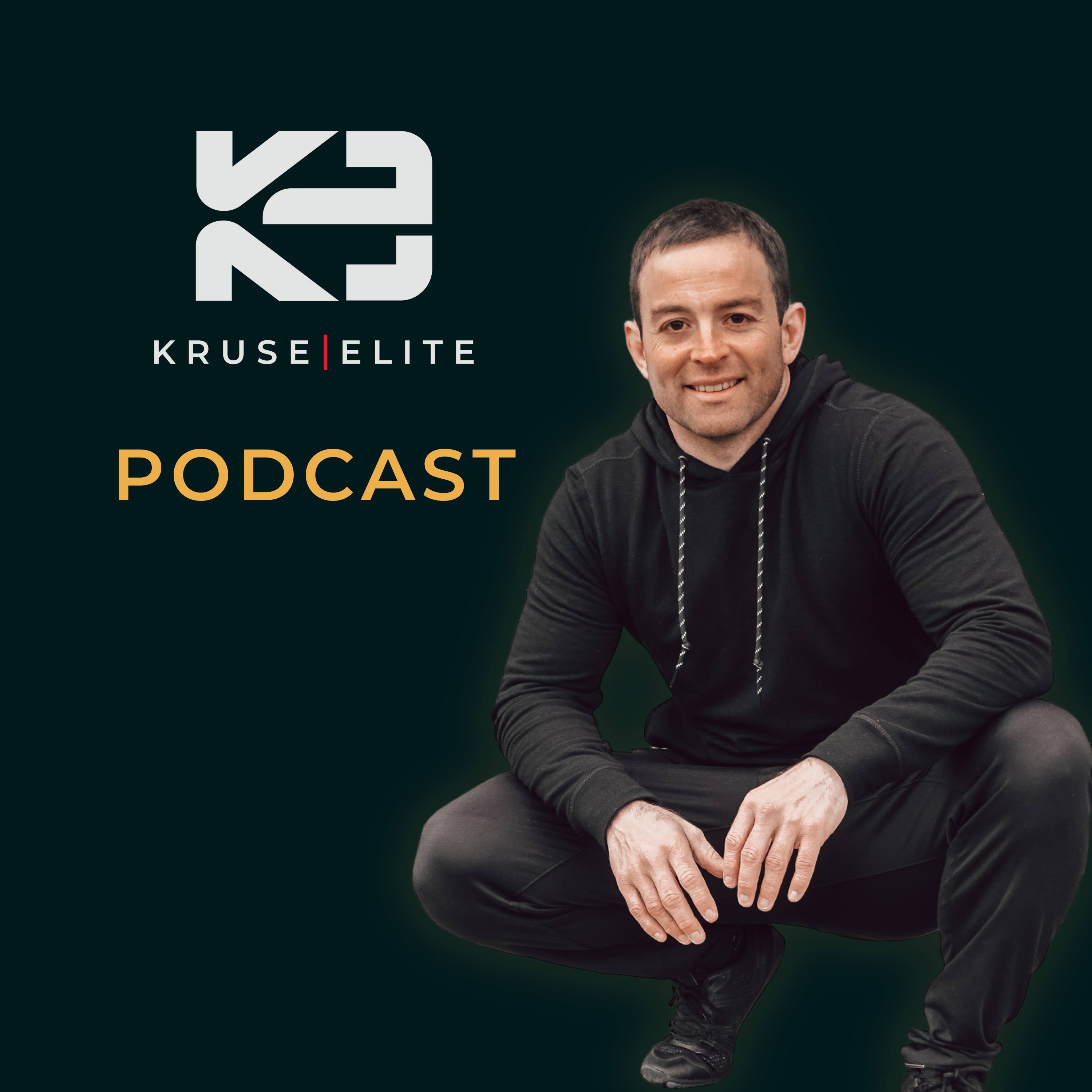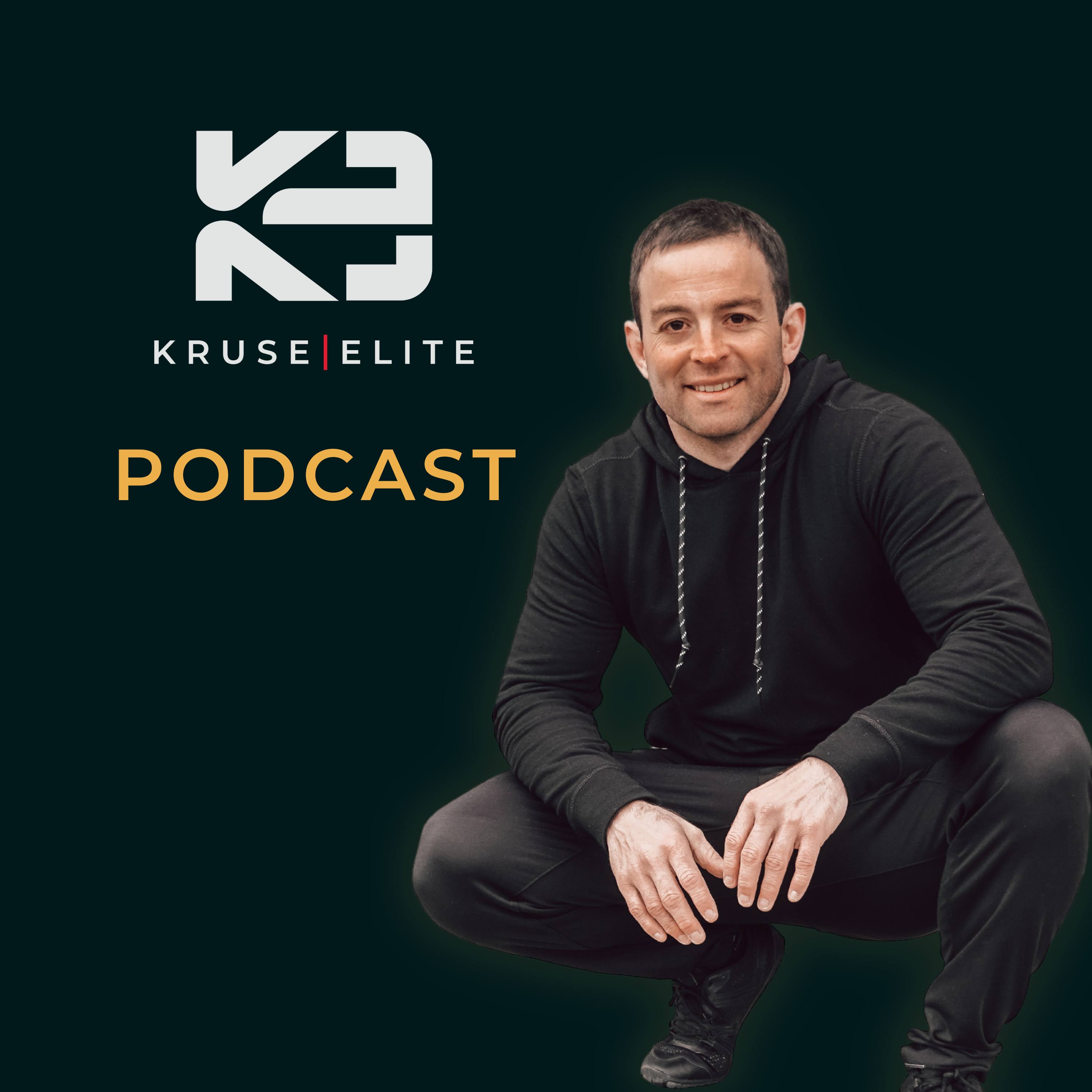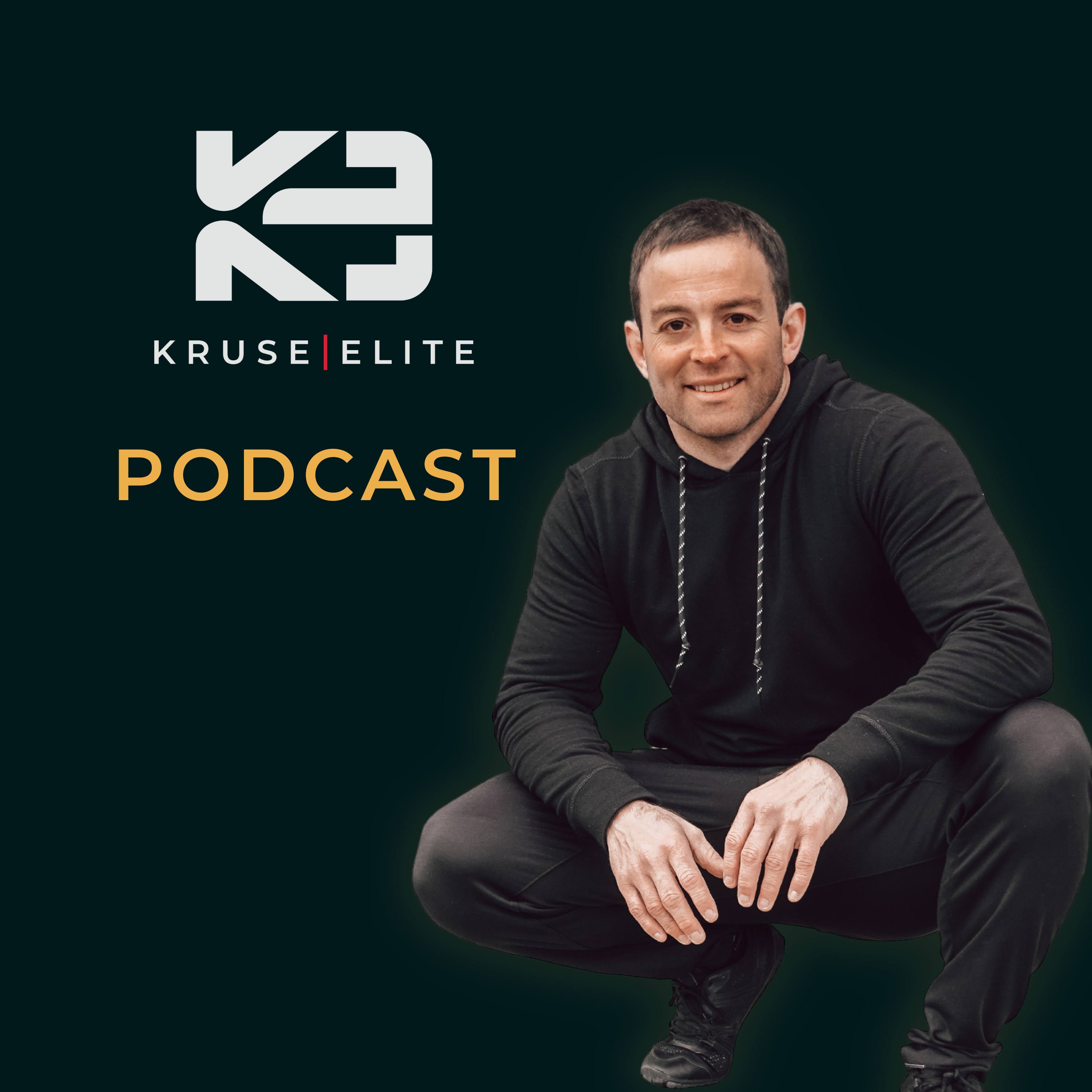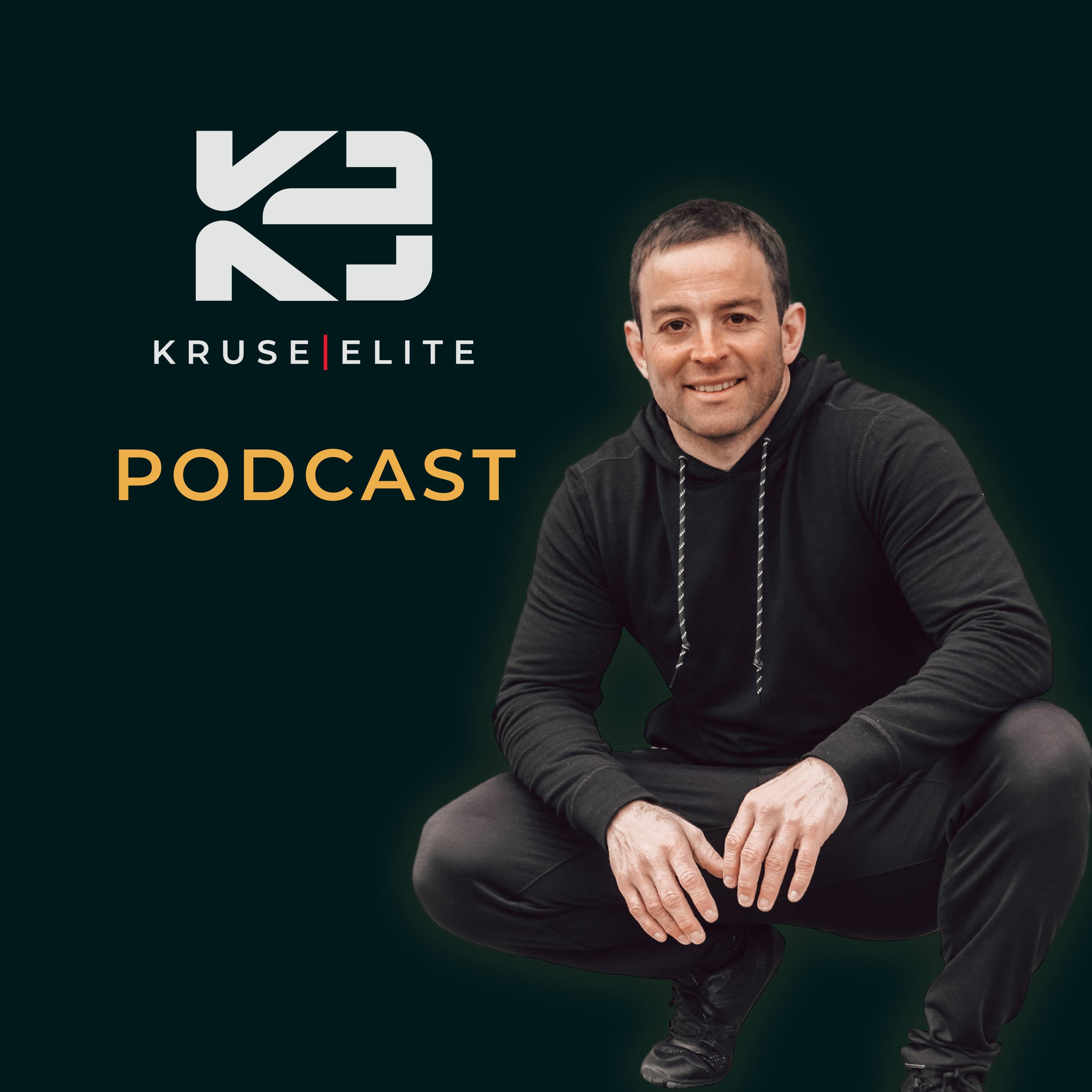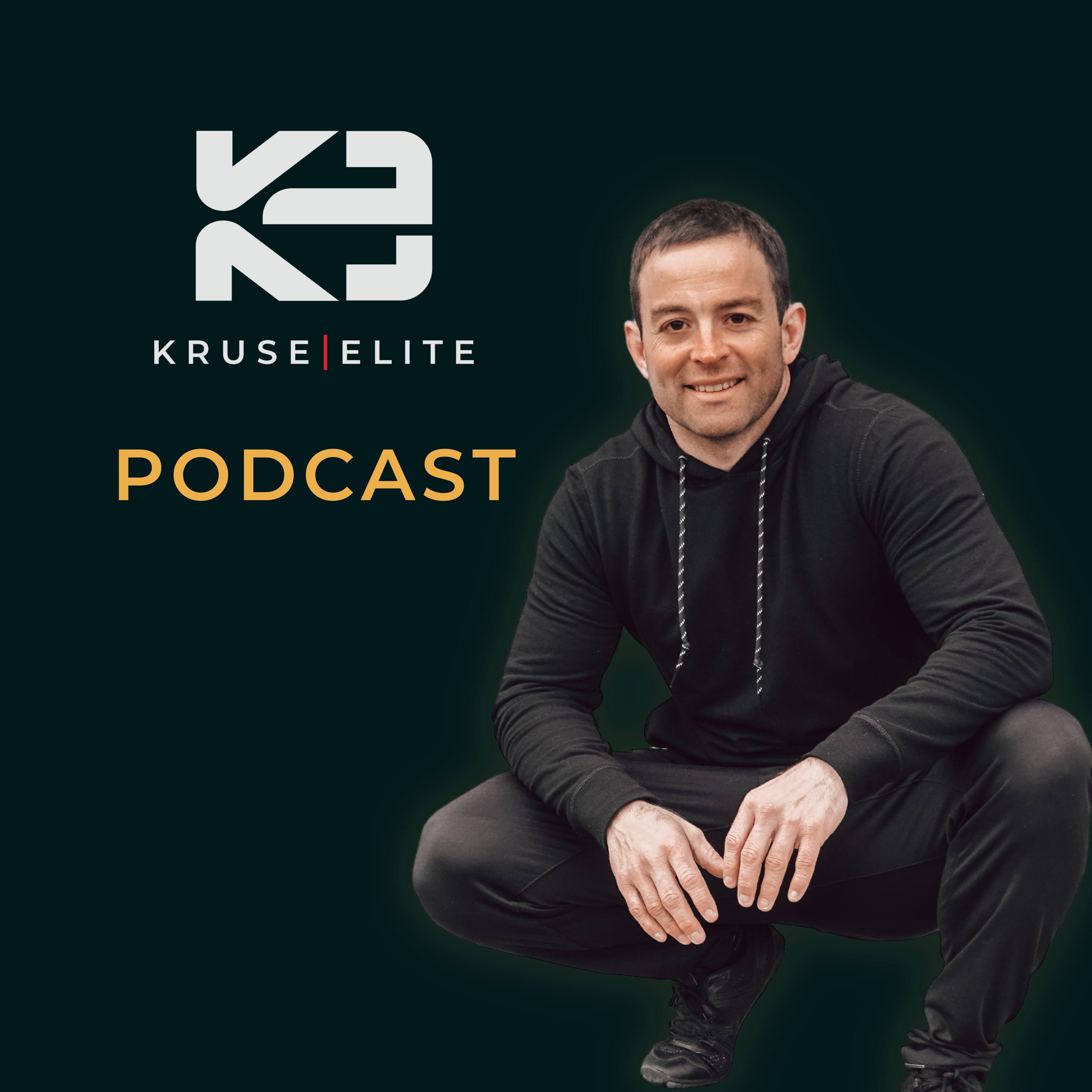Discover The KRUSE ELITE Podcast
The KRUSE ELITE Podcast

17 Episodes
Reverse
What if an old scar is causing your brain to erroneously map where your body is in space? In Part 3 of a series on the neural hierarchy, I speak with my podcast producer, Tony, all about the proprioceptive system and how our sense of where our body is in space lives not in the body, but rather in the brain. I discuss why the proprioceptive system is closely related to performance and pain, and how this system ties in with the rest of the neural hierarchy to make decisions about movement, balance, mobility and threat. By understanding how the proprioceptive mental map is made, I show how seemingly unrelated exercises that "clarify the map" can help decrease pain, increase performance, and even lessen things like anxiety and stress.
Thank you to my podcast idea man and coach, Tony Fowler (Instagram: @tone_reverie) for helping me put together this episode!
Whenever you're ready here's how we can help you:
Follow structured programs to keep your joints healthy and your muscles strong even as you age by joining the Strength & Mobility Dojo
Restore your brain-body connection by deliberately training your unique nervous system using the neurologic blueprint we provide in our specialty course, the Neuro Dojo
What if your tight calves are actually caused by a deficiency in how your brain perceives balance? In Part 2 of a series on the neural hierarchy, I speak with my podcast producer, Tony, all about the often overlooked vestibular system and how it is integrally related to balance, posture, respiration, blood pressure, and potentially, pain and performance. I discuss some clues that might make me suspect someone has a vestibular deficiency, how I can test the vestibular system, what kinds of drills and exercises you can use to train the vestibular system, and more. I also tell some powerful stories of clients that had lifelong vestibular deficits that they weren't aware of, and that when identified and targeted, led to huge improvements in quality of life and performance.
Thank you to my podcast idea man and coach, Tony Fowler (Instagram: @tone_reverie) for helping me put together this episode!
Whenever you're ready here's how we can help you:
Follow structured programs to keep your joints healthy and your muscles strong even as you age by joining the Strength & Mobility Dojo
Restore your brain-body connection to decrease pain and improve performance using the neurologic blueprint we provide in our specialty course, the Neuro Dojo
The neural hierarchy is a powerful explanatory framework for how our brain relies on sensory information when we are active, but what if the vast majority of the movement and fitness industry only focuses on the least important sensory system? Today, I speak with my podcast producer, Tony, about the neural hierarchy. I outline what the three sensory systems in the neural hierarchy are and focus on the visual system which accounts for 70% of the sensory information that our brain receives. I discuss my own challenges with visual impairment as a young athlete, how the visual system interacts with movement and athletic performance, and why a visual deficit can potentially lead to pain and injury. I also discuss how training and activating the visual system can have surprising benefits in pain management, threat reduction, and strength and coordination.
Thank you to my podcast idea man and coach, Tony Fowler (Instagram: @tone_reverie) for helping me put together this episode!
Whenever you're ready here's how we can help you:
Follow structured programs to keep your joints healthy and your muscles strong even as you age by joining the Strength & Mobility Dojo
Restore your brain-body connection by deliberately training your unique nervous system using the neurologic blueprint we provide in our specialty course, the Neuro Dojo
Have you ever managed chronic pain? Or, maybe you've struggled to come back from an injury. Maybe you've had issues with your menstrual cycle as an athlete and need some tips on how to better care for your body. All of this and more is the reality of professional athlete, Lila Lapanja. If you're interested in learning how a Professional Alpine Ski Racer has walked through this journey and is coming out the other side with better health and performance than ever, you'll love this episode.
In this episode, I interview one of our very own Strength & Mobility Dojo members, Lila Lapanja. Lila and I talk about:
Her personal experience as a Professional Alpine Ski Racer beginning as a teenager and continuing on for over a decade now
How she discovered the role your brain and nervous system plays in managing chronic pain, regulating metabolic health, and the impact it has on your overall health an lifestyle
How her perception of her chronic pain patterns has completely transformed since learning the science of pain and how to quickly resolve issues as they arise
How overhauling her training and eating habits played a massive role in improving her metabolic health and restored her menstrual cycle
How improving her metabolic and hormonal health translated into better athletic performance and helped her make wiser training decisions
Her training tips to help you restore balance to your training and to improve your health in the process
Thank you to Strength & Mobility Dojo member, Lila Lapanja for sharing your personal journey as a professional athlete learning to listen to your body so you can improve not just your performance but your overall health.
You can follow along with Lila's athletic journey here:
Website: https://www.lilalapanja.com/ Facebook: https://www.facebook.com/lapanjalila/ Instagram: https://www.instagram.com/lilalapanja/
Whenever you're ready here's how we can help you:
Follow structured programs to keep your joints healthy and your muscles strong even as you age by joining the Strength & Mobility Dojo
Restore your brain-body connection by deliberately training your unique nervous system using the neurologic blueprint we provide in our specialty course, the Neuro Dojo
The immediate feedback self-assessment process is a powerful tool, but what do you do if you're getting negative or confusing results? Today, I speak with my podcast producer, Tony, about common problems that can occur during the self-assessment process and how to know when you need to make some changes. I discuss the importance of body awareness, how changing the speed or the load of an exercise can change how your body responds, why negative results are just as important as positive ones, and why self-assessment results might change over time. I also discuss the importance of fuel capacity and the minimum effective dose, and what actually happens in your body when a drill or exercise yields an immediate effect on your movement or pain.
Thank you to my podcast idea man and coach, Tony Fowler (Instagram: @tone_reverie) for helping me put together this episode!
Whenever you're ready here's how we can help you:
Follow structured programs to keep your joints healthy and your muscles strong even as you age by joining the Strength & Mobility Dojo
Restore your brain-body connection by deliberately training your unique nervous system using the neurologic blueprint we provide in our specialty course, the Neuro Dojo
Understanding how pain works and where it comes from is one of the most important pieces of the puzzle when it comes to solving your own pain issues. Pain can be very frightening for people because they generally associate pain with damage, but this is not necessarily true. Today, my goal is to introduce you to pain science to help you learn about what pain is, where it comes from, and why it exists in the first place.
We cover these 4 main concepts:
Pain lives in the brain
Pain does not equal injury and injury does not equal pain
The severity of your pain does not dictate the severity of your problem
Just because you have pain does not mean you have a mechanical problem
Pain is a signal. It is a protective output. The goal of the pain is to get you to change your behavior in some way. So you have to ask yourself, 'what is the protective reason for my pain?'
I discuss a variety of factors that may contribute to your pain experience, a study on low back imaging of people with bulging discs or disc degeneration yet they had no pain, a story of a young gymnast with chronic back pain years after her original injury, and a review of The Threat Bucket as an educational tool to help you identify areas of your life that may be contributing to your pain experience.
Whenever you're ready here's how we can help you:
Follow structured programs to keep your joints healthy and your muscles strong even as you age by joining the Strength & Mobility Dojo
Restore your brain-body connection by deliberately training your unique nervous system using the neurologic blueprint we provide in our specialty course, the Neuro Dojo
When you have pain or mobility issues, many will offer advice on what you should do, whether it's stretching, foam rolling, certain exercises or even surgery. Today, I speak with my podcast producer, Tony, about how I think about applying interventions to relieve pain and get your body moving properly. I discuss what happens when you apply a stimulus to the body from a neurological perspective as well as how to then assess whether it's helping or not. I also discuss different types of stimuli, why it's possible to run any modality through a neurological framework to assess its effectiveness, and several different higher order systems in the body that let me hone in on my approach to interventions for pain relief and mobility. I also address the potential for the placebo effect to occur and share a story of how some of my students in the Neuro Dojo were able to eliminate my knee pain without even being in the same room as me.
Thank you to my podcast idea man and coach, Tony Fowler (Instagram: @tone_reverie) for helping me put together this episode!
Whenever you're ready here's how we can help you:
Follow structured programs to keep your joints healthy and your muscles strong even as you age by joining the Strength & Mobility Dojo
Restore your brain-body connection by deliberately training your unique nervous system using the neurologic blueprint we provide in our specialty course, the Neuro Dojo
Have you ever managed an autoimmune disorder or do you know someone who does? Engaging in fitness while managing something like Multiple Sclerosis (MS) has it's ups and downs. The goal for this episode is to share some insight into how to navigate your symptoms so you can continue to live an active, healthy lifestyle.
In this episode, I interview one of our very own Strength & Mobility Dojo members, Alissa Frazier. Alissa and I talk about:
How her MS symptoms originally presented and her medical journey to find a diagnosis
How she took things into her own hands to create a lifestyle and diet that improved her health and decreased her symptoms
Her 3 pillars for managing chronic illness: diet, movement and stress management
How she has navigated fitness so she can find the sweet spot to getting stronger and more fit without triggering flare ups or negative symptoms
My experience working with multiple clients with MS, how their symptoms presented slightly differently and how we utilized the power of strength and neuro training to slow the progression of their MS symptoms
Her advice for anyone managing a chronic illness and strategies for continuing to include exercise within your lifestyle
Thank you to Strength & Mobility Dojo member, Alissa Frazier for sharing your personal and professional journey in managing MS. To work with Alissa, check out her practice:
Instagram: Liss.MSEmail: info@liss-ms.com Website: www.liss-ms.com
Whenever you're ready here's how we can help you:
Follow structured programs to keep your joints healthy and your muscles strong even as you age by joining the Strength & Mobility Dojo
Have you ever wondered - what exactly is a minimalist shoe? Or, maybe you haven't heard of them but you need some strategies for improving your foot health. Today, I share my first introduction to minimalist shoes, how to ease into barefoot-style shoes and why it's so important to get your feet a pair of "ninja booties." I discuss some of the key features to look for in a minimalist shoe, how to perform a shoe test to identify the flexibility and mobility of the shoe itself, how conventional footwear negatively alters the way you move and can actually compress your joints, interfering with reflexes that are designed to keep your muscles strong and engaged. I also discuss strategies for transitioning into minimalist footwear and how to apply the concept of "progressive overload" to adapt to wearing barefoot shoes. I also cover some common questions like whether minimalist shoes are okay for seniors, on pavement or while hiking and situations where it might be best to alternate between conventional and minimalist footwear.
Here are two of our favorite minimalist shoe brands:
Vivobarefoot (use code: KRUSE20) To save 20% off your purchase before December 31st, 2023
Xero Shoes
*Vivobarefoot link is an affiliate link
Whenever you're ready here's how we can help you:
Follow structured programs to keep your joints healthy and your muscles strong even as you age by joining the Strength & Mobility Dojo
The hardest people for me to help are the ones that aren't moving on a regular basis. Today, I speak with my podcast producer, Tony, about why inactivity leads to all sorts of other problems downstream and why it's so important to maintain a regular movement practice. I discuss some of the main causes of inactivity, from pain and injury to sedentary lifestyles, and dig into some core concepts like the movement box and the pain vortex, that can help us understand what happens when your movement has been compromised. I also discuss how to approach injuries, some common myths and misconceptions around healing from injury, the use of "crude touch" and other non-intuitive methods to help with pain and mobility, why motivation is less effective than habit, why I no longer use the functional movement screen, and more.
Thank you to my podcast idea man and coach, Tony Fowler (Instagram: @tone_reverie) for helping me put together this episode!
Whenever you're ready here's how we can help you:
Follow structured programs to keep your joints healthy and your muscles strong even as you age by joining the Strength & Mobility Dojo
Restore your brain-body connection by deliberately training your unique nervous system using the neurologic blueprint we provide in our specialty course, the Neuro Dojo
Have you ever managed chronic pain? And, maybe you wake up wondering what's going to hurt next, maybe it's your knee or your hip and then it's your shoulder. If you've ever dealt with pain and have spent endless hours searching for resolutions, this episode is for you.
In this episode, I interview one of our very own Strength & Mobility Dojo members, Dr. Shaun Puro. Shaun and I talk about:
His personal experience with chronic pain and what it was like running into dead end after dead end
How he discovered the role your brain and nervous system plays in managing chronic pain when he joined our original hip mobility challenge
How modifying his strength workouts and integrating high payoff exercises were a game changer for him
How he is integrating applied neurology into his professional practice as a Chiropractor to support his patients out of pain
Strategies for managing the inevitable ups and downs that come with moving out of chronic pain
Thank you to Strength & Mobility Dojo member, Dr. Shaun Puro for sharing your personal and professional journey in managing pain. To work with Shaun, check out his practice:
AlternaHealth Solutions, located in Roswell,Ga. Website: https://www.alternahealthsolutions.com/ Facebook: AlternaHealth SolutionsOffice Number: 770-641-9797
Whenever you're ready here are two ways we can help you:
Participate in one of our mobility challenges by joining our FREE community called "The Dojo."
Follow structured programs to keep your joints healthy and your muscles strong even as you age by joining the Strength & Mobility Dojo
How often do you think about breathing? Breathing is something we do all day, every day, 24/7, and yet many of us have some form of dysfunctional breathing. Today, I talk with my podcast producer, Tony, about how I learned that breathing dysfunction is often linked to pain and other seemingly unrelated problems, and that fixing your breathing is one of my go to solutions for difficult to solve issues with my clients. I talk about mouth breathing and upper chest breathing vs nasal breathing and how breathing patterns can be linked to anxiety, stress, pain, lack of energy, and more. I also discuss different breathing techniques and strategies from mouth tape to air hunger squats, how to assess your breathing and whether different breathing techniques are working for you, and how to train your breathing for better results in fitness but also in everyday life.
Thank you to my podcast idea man and coach, Tony Fowler (Instagram: @tone_reverie) for helping me put together this episode!
Whenever you're ready here's how we can help you:
Follow structured programs to keep your joints healthy and your muscles strong even as you age by joining the Strength & Mobility Dojo
Restore your brain-body connection by deliberately training your unique nervous system using the neurologic blueprint we provide in our specialty course, the Neuro Dojo
Have you ever wondered how a young athlete becomes a trainer, coach, and educator? Or just how someone might get into brain-based fitness in general? Today, I’m going to talk with my podcast producer, Tony, about how I got started from a young age in fitness, and how my training and understanding evolved into the neuro-muscular approach that I use today. I go over my first experiences in strength training, wrestling and physical education, my own struggles with chronic pain and injuries, my introduction to the Burdenko Method, my discovery of Z-Health and diving deep into applied neuroscience, and how I finally was able to solve problems with chronic pain for not only myself, but for my clients as well. I also share some of my current challenges as I continue to learn and grow as coach and educator. It's been quite a journey and I'm excited to share my story with you.
Thank you to my podcast idea man and coach, Tony Fowler (Instagram: @tone_reverie) for helping me put together this episode!
Whenever you're ready here's how we can help you:
Follow structured programs to keep your joints healthy and your muscles strong even as you age by joining the Strength & Mobility Dojo
Restore your brain-body connection by deliberately training your unique nervous system using the neurologic blueprint we provide in our specialty course, the Neuro Dojo
Is your workout routine leaving you tired, sore, and stressed all the time? Or, on the other hand, do you feel like you never seem to make much progress despite sticking to a program you like? Is there something that you know you’re “supposed to do” in your routine but that you always skip? Today, I’m going to talk about balance in training, what it looks like and why it is so important to keep in mind over the long run. I’m also going to talk about how you can assess whether your own training is balanced and healthy, or if you are missing the mark and setting yourself up for trouble down the line. If you are someone that wants to stay active and injury free for as long as possible, so you can keep doing the things that you love, then this episode is for you.
Thank you to my podcast idea man and coach, Tony Fowler (Instagram: @tone_reverie) for helping me put together this episode!
Whenever you're ready here's how we can help you:
Follow structured programs to keep your joints healthy and your muscles strong even as you age by joining the Strength & Mobility Dojo
Restore your brain-body connection by deliberately training your unique nervous system using the neurologic blueprint we provide in our specialty course, the Neuro Dojo
In this episode of the Kruse Elite Podcast, I share a brief story about how I injured my hamstring with stretching. I explain how using a "seek and destroy" mentality and chasing tightness with repetitive stretching is a bad idea. I introduce some simple solutions that are much more effective tools for when you have that stubborn chronic tension that just wont go away. And, how you can actually assess your response to any exercise that you're trying by using our immediate feedback assessment process, which is a total game changer! If you want to learn more about the assessment part, check out episode 1: The Threat Bucket & How to Assess Your Body’s Response to Exercise.Thank you to my podcast idea man and coach, Tony Fowler (Instagram: @tone_reverie) for helping me put together this episode!
Whenever you're ready here are two ways we can help you:
Participate in one of our free monthly mobility challenges by joining our FREE community called "The Dojo."
Follow structured programs to keep your joints healthy and your muscles strong even as you age by joining the Strength & Mobility Dojo.
In this episode I'll teach you my #1 exercise for eliminating low back tension, improving total body mobility and more! I even take you through an assessment process so that you can understand how your body is responding to the exercise. I hope you enjoy this episode and, if you do, please leave a review on iTunes.Finally, if you want to learn more about the Diaphragm Stretch and other exercises for improving your health and performance join our free community. Every month we host free mobility challenges and I personally take you through the assessment process - teaching you how to make it specific to your needs!Back Lying Diaphragm Stretch VideoWhenever you're ready here are two ways we can help you: Participate in one of our free monthly mobility challenges by joining our FREE community called "The Dojo." Follow structured programs to keep your joints healthy and your muscles strong even as you age by joining the Strength & Mobility Dojo.
In this episode of the Kruse Elite podcast, I introduce you to my favorite educational tool called the Threat Bucket and guide you through a simple 3 step assessment process that you can use to understand your body's response to any exercise. This is the exact process that I used to get myself out of chronic pain and it's the process that I use with all of our clients and members to help them achieve their goals with moving better and eliminating pain! I hope you enjoy this episode and, if you do, please leave a review on iTunes. Finally, if you want to learn more about the Threat Bucket and our immediate feedback assessment process, join our free community! Every month we host free mobility challenges and I personally take you through the assessment process - teaching you how to make it specific to your needs!Video demo of Lateral Ankle Tilts: https://youtu.be/zMgVIt25_s0Whenever you're ready here are two ways we can help you: Participate in one of our free monthly mobility challenges by joining our FREE community called "The Dojo." Follow structured programs to keep your joints healthy and your muscles strong even as you age by joining the Strength & Mobility Dojo.



